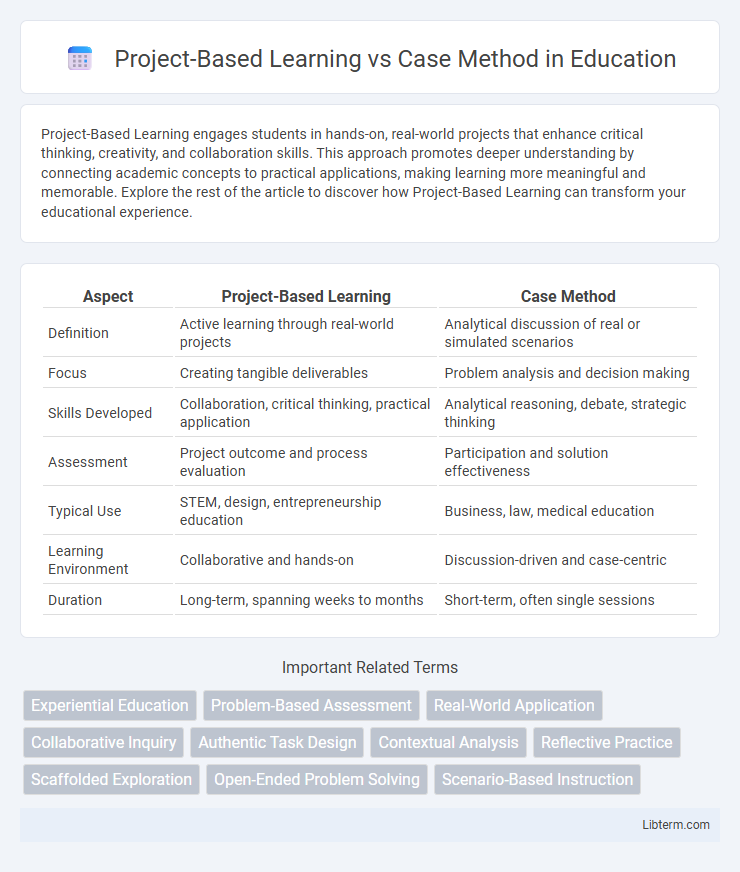Project-Based Learning engages students in hands-on, real-world projects that enhance critical thinking, creativity, and collaboration skills. This approach promotes deeper understanding by connecting academic concepts to practical applications, making learning more meaningful and memorable. Explore the rest of the article to discover how Project-Based Learning can transform your educational experience.
Table of Comparison
| Aspect | Project-Based Learning | Case Method |
|---|---|---|
| Definition | Active learning through real-world projects | Analytical discussion of real or simulated scenarios |
| Focus | Creating tangible deliverables | Problem analysis and decision making |
| Skills Developed | Collaboration, critical thinking, practical application | Analytical reasoning, debate, strategic thinking |
| Assessment | Project outcome and process evaluation | Participation and solution effectiveness |
| Typical Use | STEM, design, entrepreneurship education | Business, law, medical education |
| Learning Environment | Collaborative and hands-on | Discussion-driven and case-centric |
| Duration | Long-term, spanning weeks to months | Short-term, often single sessions |
Introduction to Project-Based Learning and Case Method
Project-Based Learning (PBL) engages students in real-world projects, fostering critical thinking, collaboration, and hands-on experience by solving complex, authentic problems over extended periods. The Case Method involves analyzing specific, detailed scenarios to develop decision-making and analytical skills through discussion and reflection on real or simulated business situations. Both approaches emphasize active learning but differ in structure, with PBL focusing on creating tangible outcomes, while the Case Method prioritizes in-depth scenario analysis.
Historical Development of Each Approach
Project-Based Learning (PBL) originated in the early 20th century with educational reformers like John Dewey, emphasizing experiential learning through active student engagement in real-world projects to develop critical thinking and problem-solving skills. The Case Method, pioneered by Harvard Business School in the 1920s, evolved as a pedagogical strategy to simulate decision-making processes by analyzing real-life business scenarios, fostering analytical reasoning and discussion. Both approaches have progressively shaped modern education by integrating practical application with theoretical knowledge, yet PBL centers on producing tangible outcomes, while the Case Method focuses on reflective analysis and debate.
Core Principles of Project-Based Learning
Project-Based Learning centers on student-driven inquiry, collaboration, and real-world problem solving, where learners actively construct knowledge by engaging in extended projects tied to authentic contexts. It emphasizes inquiry, reflection, and iterative assessment to deepen understanding and develop critical thinking, creativity, and communication skills. Unlike the Case Method, which focuses on analyzing specific scenarios, Project-Based Learning integrates interdisciplinary content through hands-on activities to foster practical application and sustained engagement.
Foundational Elements of the Case Method
The Case Method centers on real-world scenarios requiring students to analyze complex problems, fostering critical thinking and decision-making skills through active discussion and debate. Foundational elements include detailed case narratives, guided questioning, and facilitation by instructors to stimulate multiple perspectives and practical application. This contrasts with Project-Based Learning, which emphasizes hands-on creation and extended projects rather than analytical discourse.
Key Differences Between Project-Based Learning and Case Method
Project-Based Learning emphasizes hands-on creation and problem-solving over an extended period, allowing students to develop practical skills through real-world projects. The Case Method centers on analyzing and discussing specific scenarios, promoting critical thinking and decision-making by examining theoretical and practical implications. Project-Based Learning fosters active experimentation and collaboration, while the Case Method encourages reflection and debate within a structured classroom setting.
Advantages of Project-Based Learning
Project-Based Learning (PBL) enhances critical thinking and problem-solving skills by engaging students in real-world challenges that require active exploration and collaboration. The hands-on approach in PBL fosters deeper understanding and retention of knowledge compared to the Case Method, which primarily focuses on analyzing predefined scenarios. PBL also cultivates creativity and adaptability by encouraging learners to design solutions, managing resources and timelines, promoting practical skills essential for workforce readiness.
Strengths of the Case Method
The Case Method excels in developing critical thinking and decision-making skills through real-world scenarios that replicate complex business challenges. It encourages active participation and debate, fostering deep understanding and the ability to apply theoretical knowledge in practical contexts. This method enhances analytical abilities and communication skills, preparing learners to navigate ambiguity and make informed decisions in dynamic environments.
Challenges and Limitations of Both Methods
Project-Based Learning often faces challenges such as resource intensity, requiring significant time, materials, and instructor expertise, which can hinder consistent implementation. The Case Method can be limited by its reliance on well-crafted scenarios that may oversimplify complex real-world issues, restricting students' ability to develop practical skills. Both methods may struggle with assessing individual contributions and ensuring equal participation, impacting the overall effectiveness of collaborative learning experiences.
Best Practices for Implementation
Project-Based Learning (PBL) thrives by integrating real-world challenges that promote active collaboration, critical thinking, and continuous assessment, ensuring students develop practical skills aligned with curriculum goals. The Case Method excels through structured discussions of specific scenarios that sharpen analytical reasoning and decision-making, facilitated by skilled instructors who guide reflection and knowledge application. Best practices for implementation emphasize clear objectives, authentic materials, timely feedback, and fostering an interactive environment that encourages student engagement and deeper understanding.
Choosing the Right Approach for Your Educational Goals
Project-Based Learning emphasizes hands-on, real-world problem solving that fosters collaboration, creativity, and critical thinking, ideal for developing practical skills and interdisciplinary knowledge. The Case Method promotes analytical thinking and decision-making by dissecting complex scenarios, making it suited for professions requiring strategic judgment, such as law or business. Selecting the right approach depends on whether your educational goals prioritize applied experience and teamwork or in-depth analysis and discussion of real-world dilemmas.
Project-Based Learning Infographic

 libterm.com
libterm.com